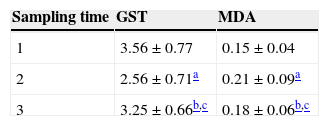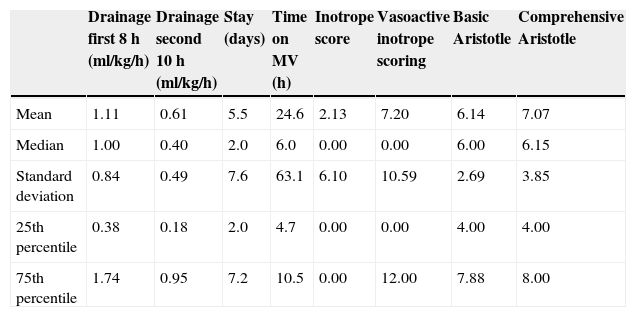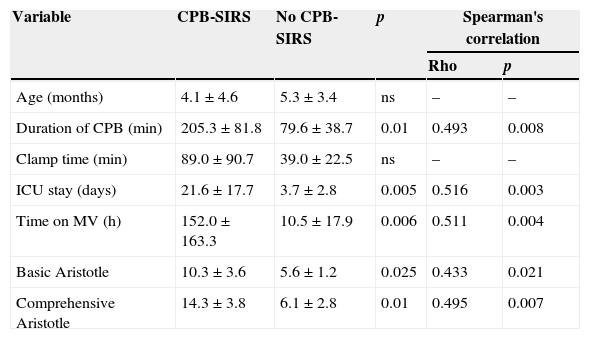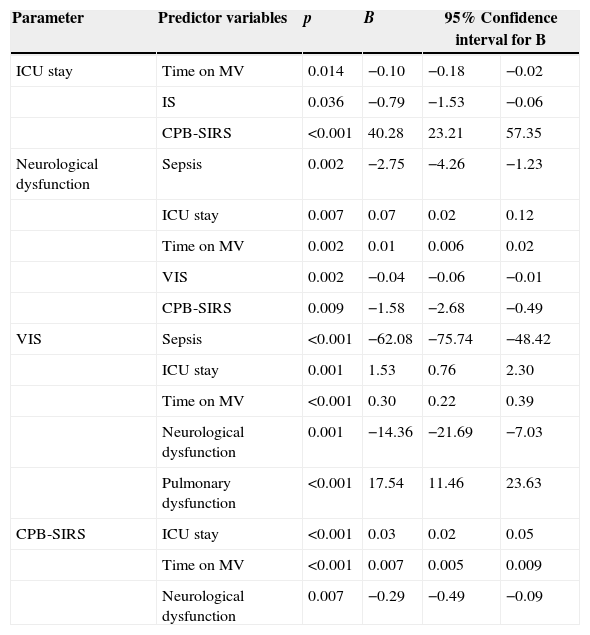To analyse the trend in lipid peroxidation and antioxidant response as key markers of oxidative stress after paediatric cardiovascular surgery, and compare them with other internationally accepted clinical prognostic indicators.
Patients and methodsA prospective study was conducted on 30 children aged one month to 14 years, weight>5kg, undergoing cardiopulmonary bypass surgery. Blood samples were taken just before the intervention, immediately after surgery, and after 18–20h. Cell membrane lipid peroxidation was analysed by quantifying malondialdehyde, as well as measuring total glutathione (oxidised and reduced), as representatives of antioxidant response. An analysis was also performed on clinical variables for establishing a score for the systemic inflammatory response syndrome associated with cardiopulmonary bypass.
ResultsThe study included 30 children with a mean age of 4.1 years old (interquartile range [IQR]: 2.7; 8.0). Of these, 62.1% were girls. The standard deviation of the median weight was −0.39 (IQR: −0.76; 0.24), the median height was −0.22 (IQR: −0.74; 0.27), and the median BMI was −0.43 (IQR: −1; 0.45). The final surgery times were divided into 2 parts: total time of extracorporeal circulation, with a mean of 79min (IQR: 52.5; 125.5), and the clamping time, a measurement included in the previous figure with a mean value of 38.5min (IQR: 22; 59). Malondialdehyde increased and glutathione decreased in postoperative time, with clear, statistically significant direct correlation between time of extracorporeal circulation and percentage decrease in total glutathione between preoperative and immediate postoperative time, and a decline between the preoperative and late postoperative. There was a statistical correlation between total glutathione levels at 18–20h postoperatively and the duration of mechanical ventilation and inflammatory systemic response syndrome.
ConclusionsSurgery with extracorporeal circulation performed in children activates inflammatory mediators, being maximum after aortic clamping, and improving after the first 24h. The level of oxidative stress activation depends on surgical times. The development of systemic inflammatory response syndrome is associated with longer duration of mechanical ventilation, longer stay in intensive care, higher scores in the Aristotle model and longer surgical times. Those who do not meet criteria for inflammatory response have higher levels of glutathione in first 24h.
Analizar la evolución de parámetros de estrés oxidativo en el posoperatorio de cirugía cardiovascular pediátrica y correlacionarlos con diferentes indicadores clínicos pronósticos.
Material y métodosTreinta niños, de entre un mes y 14 años, peso > 5kg, sometidos a circulación extracorpórea. Se obtuvieron muestras preoperatoria, posoperatoria inmediata y tras 18–20h. Se analizó la capacidad de peroxidación lipídica de las membranas celulares mediante la cuantificación de productos de reacción con el ácido tiobarbitúrico, cuyo principal representante es el malondialdehído; se cuantificó el contenido celular de glutatión total, oxidado y reducido (representantes de la respuesta antioxidante). Se analizaron las variables clínicas que permitieran establecer una puntuación para el síndrome de respuesta inflamatoria sistémica asociado a circulación extracorpórea.
ResultadosTreinta pacientes con una mediana de edad de 4,1 años (rango intercuartílico [RIC]: 2,7; 8,0); el 62,1% eran niñas; mediana de desviaciones estándar de peso −0,39 (RIC: −0,76; 0,24), de talla −0,22 (RIC: −0,74; 0,27) y de IMC −0,43 (RIC: −1; 0,45). Mediana de tiempo quirúrgico 79min (RIC: 52,5; 125,5), mediana de pinzamiento 38,5min (RIC: 22; 59). Aumentó el malondialdehído y disminuyó el glutatión en ambos momentos posoperatorios, con clara correlación directa, estadísticamente significativa, del tiempo de circulación extracorpórea con el porcentaje de descenso de glutatión total entre preoperatorio y posoperatorio inmediato y entre el preoperatorio y el posoperatorio tardío. Hubo una correlación estadística entre los niveles de glutatión total tras 18–20h posoperatorias y el tiempo de duración de la ventilación mecánica y la pertenencia al grupo de síndrome de respuesta inflamatoria sistémica.
ConclusionesLa circulación extracorpórea activa mediadores inflamatorios, máximo tras el pinzamiento aórtico, mejorando tras 24h, siendo dependiente de los tiempos quirúrgicos. El desarrollo de respuesta inflamatoria está asociado a una mayor duración de la ventilación mecánica, una estancia más prolongada en Cuidados Intensivos, puntuaciones mayores del Modelo de Aristóteles y tiempos más largos quirúrgicos. Los que no cumplen criterios de respuesta inflamatoria tienen más niveles de glutatión en el posoperatorio tardío.
Artículo
Comprando el artículo el PDF del mismo podrá ser descargado
Precio 19,34 €
Comprar ahora













